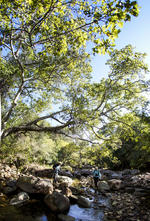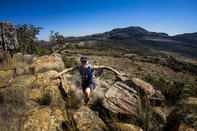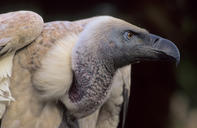Hiking

Blouberg Nature Reserve has a number of short hiking options which are easily accessible from Blouberg camp, and camp guides will be more than happy to accompany you onto these trails. There is not much in the line of signage, so it is definitely best to have some local knowledge if you’re planning on heading up into the surrounding mountains.
The hike up to Ledjiba la Makgowa, or ‘Pools of the Whites’ - named for police officers and village elders blessed with wisdom who came here to swim on weekends - is a relatively flat return walk of around 4 km. Crystal-clear cascades and giant boulders await you at the end of the rocky trail winding along the river course amid towering candelabra euphorbia, ficus and acacia trees.
The route to the summit of Blouberg Peak itself is not obvious at all, and for most people this would constitute a full day out. Crossing the river takes you onto the Wise Pools Trail, but you soon split left to start climbing towards the neck between the peak and the precipitous cliffs to the north of the camp.
Upon the grassland plateau, you pass an interesting abandoned village and then continue to the Blouberg Mountain Camp, where you can overnight if you arrange this in advance. The final push to the summit is a tough ascent through broken ground.
Climbing

Blouberg Nature Reserve boasts a range of exposed and challenging routes of up to 12 pitches in total. The looming North Wall is rated as one of the best big-wall climbs in Southern Africa, with a superb vista unfolding across the Vhembe Biosphere region. Reaching the face is an expedition in itself, with various approaches - the hike from the farm Isaac’s Kraal is probably the best-known route in.
Without a guide, the approach could potentially take you the whole day, and once you get to the base of the cliff, you are in for some hardcore climbing. There are no easy routes - all are very long, sustained and exposed and take note: their grading may lull you into a false sense of security. Last Moon is one of the easier routes in Blouberg Nature Reserve, with awesome climbing to be had on the adjacent Chickenheads or Teddy Bears’ Picnic. The area is extremely remote and this adds to the psychological challenge of climbing here.
Birding

The bird you really want to spot here in the Blouberg Nature Reserve, is the elusive African wood owl, so listen out for its melodious hooting while sitting around the fire at night. Not to be missed are the Cape vulture and Verreaux’s eagle; both species may be spotted from the camp, but hiking to the summit will get you much closer to these majestic birds.
Blouberg Nature Reserve alone boasts an impressive bird list species, the most famous of which is the Cape vulture (Gyps coprotheres). The breeding colony in the cliffs has around 800 breeding pairs and is certainly an important stronghold for this threatened species. The birds can often be seen up close, especially in winter at the Vulture Restaurant, where carcasses are provided on an ad hoc basis.
Some of the other species you may see include Crested guineafowl, African hawk-eagle, Common quail, Bar-throated apalis, Acacia pied barbet and Freckled nightjar.